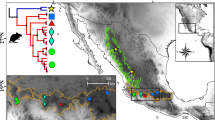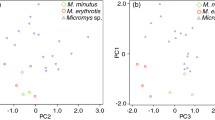Abstract
Bandicoot rats (genus Bandicota), widely known as rodent pests, are abundant and widespread throughout the continental part of the Indo-Malayan realm. However, their evolutionary history is not yet well understood. The molecular phylogenetic relationships of the three bandicoot rat species, Bandicota bengalensis, Bandicota indica, and Bandicota savilei, were assessed based on the gene sequences of the specimens collected from Myanmar, where all three species occur along with database sequences. Early divergence of B. savilei (1.5–1.7 million years ago) was inferred from the mitochondrial cytochrome b (Cytb) gene and the nuclear interphotoreceptor retinoid-binding protein (Irbp), and melanocortin 1 receptor (Mc1r) gene sequences. The Cytb lineage of B. bengalensis from Sri Lanka was distinct from the monophyletic lineage of the continental lineages of B. bengalensis and B. indica. This can be explained by the preservation of ancient mitochondrial DNA (mtDNA) in the insular population owing to female philopatry and male dispersal, given that no substantial intraspecies geographic subdivision was observed in the nuclear markers. The paraphyletic relationship of B. bengalensis with B. indica may be explained by introgression of the mtDNA from B. bengalensis to B. indica, but further investigation is required to confirm this. B. bengalensis Cytb sequences from a wide area of Myanmar had limited nucleotide diversity (π = 0.00079), implying that the genetic diversity of B. bengalensis in Myanmar was acquired through Holocene human activities.



Similar content being viewed by others
References
Aplin KP, Suzuki H, Chinen AA, R. Chesser T, Have Jt, Donnellan SC, Austin J, Frost A, Gonzalez JP, Herbreteau V, Catzeflis F, Soubrier J, Fang YP, Robins J, Matisoo-Smith E, Bastos ADS, Maryanto I, Sinaga MH, Denys C, Van Den Bussche RA, Conroy C, Rowe K, Cooper AM, Thomas GP (2011) Multiple Geographic Origins of Commensalism and Complex Dispersal History of Black Rats. PLoS ONE 6(11):e26357
Boratyński Z, Melo-Ferreira J, Alves PC, Berto S, Koskela E, Pentikäinen OT, Tarroso P, Ylilauri M, Mappes T (2014) Molecular and ecological signs of mitochondrial adaptation: consequences for introgression? Heredity 113:277–286
Camacho-Sanchez M, Leonard JA, Fitriana Y, Tilak MK, Fabre PH (2017) The generic status of Rattus annandalei (Bonhote, 1903) (Rodentia, Murinae) and its evolutionary implications. J Mammal 98:1340–1355
Drummond AJ, Rambaut A (2007) BEAST: Bayesian evolutionary analysis by sampling trees. BMC Evol Biol 7:214
Fabre PH, Hautier L, Dimitrov D, Douzery EJ (2012) A glimpse on the pattern of rodent diversification: a phylogenetic approach. BMC Evol Biol 12:88
Felsenstein J (1981) Evolutionary trees from DNA sequences: a maximum likelihood approach. J Mol Evol 17:368–376
Felsenstein J (1985) Confidence limits on phylogenies: an approach using the bootstrap. Evolution 39:783–791
Filatov DA (2009) Processing and population genetic analysis of multigenic datasets with ProSeq3 software. Bioinformatics 25:3189–3190
Hanazaki K, Tomozawa M, Suzuki Y, Kinoshita G, Yamamoto M, Irino T, Suzuki H (2017) Estimation of the evolutionary rates of mitochondrial DNA in two Japanese wood mouse species based on calibrations with quaternary environmental changes. Zool Sci 34:201–210
Hoelzer GA (1997) Inferring phylogenies from mtDNA variation: mitochondrial-gene trees versus nuclear-gene trees revisited. Evolution 51:622–626
Honda A, Murakami S, Harada M, Tsuchiya K, Kinoshita G, Suzuki H (2019) Late Pleistocene climate change and population dynamics of Japanese Myodes voles inferred from mitochondrial cytochrome b sequences. J Mammal 100:1156–1168
Jansa SA, Weksler M (2004) Phylogeny of muroid rodents: relationships within a nd among major lineages as determined by IRBP gene sequences. Mol Phylogenet Evol 31:256–276
Kambe Y, Tanikawa T, Matsumoto Y, Tomozawa M, Aplin KP, Suzuki H (2011) Origin of agouti-melanistic polymorphism in wild Black Rats (Rattus rattus) inferred from Mc1r gene sequences. Zool Sci 28:560–568
Kearns AM, Joseph L, Toon A, Cook LG (2014) Australia’s arid-adapted butcherbirds experienced range expansions during Pleistocene glacial maxima. Nature Comm 5:1–11
Kimura Y, Hawkins MT, McDonough MM, Jacobs LL, Flynn LJ (2015) Corrected placement of Mus-Rattus fossil calibration forces precision in the molecular tree of rodents. Sci Rep 5:14444
Kodama S, Nunome M, Moriwaki K, Suzuki H (2015) Ancient onset of geographical divergence, interpopulation genetic exchange, and natural selection on the Mc1r coat-colour gene in the house mouse (Mus musculus). Biol J Linn Soc 114:778–794
Kosoy M, Khlyap L, Cosson JF, Morand S (2015) Aboriginal and invasive rats of genus Rattus as hosts of infectious agents. Vector Borne Zoonotic Dis 15:3–12
Kumar S, Stecher G, Tamura K (2016) MEGA7: molecular evolutionary genetic analysis version 7.0 for bigger datasets. Mol Biol Evol 33:1870–1874
Michaux JR, Chevret P, Filippucci MG, Macholan M (2002) Phylogeny of the genus Apodemus with a special emphasis on the subgenus Sylvaemus using the nuclear IRBP gene and two mitochondrial markers: cytochrome b and 12S rRNA. Mol Phylogenet Evol 23:123–136
Michaux J, Chevret P, Renaud S (2007) Morphological diversity of Old World rats and mice (Rodentia, Muridae) mandible in relation with phylogeny and adaptation. J Zool Syst Evol Res 45:263–279
Musser GG, Carleton MD (2005) Superfamily Muroidea. In: Wilson DE, Reeder DM (eds) Mammal species of the world: a taxonomic and geographic reference, 3rd edn. The Johns Hopkins University Press, Baltimore, pp 894–1531
Myat Myat Zaw K, Thidalay T, Shimada T, Maung Maung Theint S, Saing KM, Bawm S, Katakura K, Suzuki H (2019) Molecular characterization of species of the subgenus Mus from Myanmar. Zool Sci 36:299–305
Nater A, Nietlisbach P, Arora N, van Schaik CP, van Noordwijk MA, Willems EP, Singleton I, Wich SA, Goossens B, Warren KS, Verschoor EJ, Perwitasari-Farajallah D, Pamungkas J, Krützen M (2011) Sex-biased dispersal and volcanic activities shaped phylogeographic patterns of extant orangutans (genus: Pongo). Mol Biol Evol 28:2275–2288
Pagès M, Chaval Y, Herbreteau V, Waengsothorn S, Cosson JF, Hugot JP, Morand S, Michaux J (2010) Revisiting the taxonomy of the Rattini tribe: a phylogeny-based delimitation of species boundaries. BMC Evol Biol 10:184
Posada D, Buckley T (2004) Model selection and model averaging in phylogenetics: advantages of Akaike information criterion and Bayesian approaches over likelihood ratio tests. Syst Biol 53:793–808
Rambaut A, Suchard MA, Xie D, Drummond AJ (2014) Tracer 1.6. URL: http://www.beastbioedacuk/tracer. Accessed 12 Feb 2018
Poux C, Douzery EJP (2004) Primate phylogeny, evolutionary rate variations, and divergence times: a contribution from the nuclear gene IRBP. Am J Phys Anthropol 124(1):01–16
Rowe KC, Achmadi AS, Esselstyn JA (2016) A new genus and species of omnivorous rodent (Muridae: Murinae) from Sulawesi, nested within a clade of endemic carnivores. J Mammal 97:978–991
Schenk JJ, Rowe KC, Steppan SJ (2013) Ecological opportunity and incumbency in the diversification of repeated continental colonizations by muroid rodents. Syst Biol 62:837–864
Serizawa K, Suzuki H, Tsuchiya K (2000) A phylogenetic view on species radiation in Apodemus inferred from variation of nuclear and mitochondrial genes. Biochem Genet 38:27–40
Shaw KL (2002) Conflict between nuclear and mitochondrial DNA phylogenies of a recent species radiation: what mtDNA reveals and conceals about modes of speciation in Hawaiian crickets. Proc Nat Acad Sci 99:16122–16127
Shimada T, Aplin KP, Jenkins P, Suzuki H (2007a) Rediscovery of Mus nitidulus Blyth, 1859 (Rodentia, Muridae), an endemic murine rodent of the central basin of Myanmar. Zootaxa 1498:45–68
Shimada T, Aplin KP, Jyogahara K, Lin LK, Herbreteau V, Gonzalez JP, Suzuki H (2007b) Complex phylogeographic structuring in a continental small mammal from East Asia, the rice field mouse, Mus caroli (Rodentia, Muridae). Mammal Study 32:49–62
Shimada T, Sato JJ, Aplin KP, Suzuki H (2009) Comparative analysis of evolutionary modes in Mc1r coat color gene in wild mice and mustelids. Genes Genet Syst 84:225–231
Shimada T, Aplin KP, Kinoshita G, Vogel P, Kryukov AP, Jin M-L et al (2010) Mus lepidoides (Muridae, Rodentia) of Central Burma is a distinct species of potentially great evolutionary and biogeographic significance. Zool Sci 27:449–459
Stephens M, Smith NJ, Donnelly P (2001) A new statistical method for haplotype reconstruction from population data. Am J Hum Genet 68:978–989
Steppan SJ, Adkins RM, Spinks PQ, Hale C (2005) Multigene phylogeny of the Old World mice, Murinae, reveals distinct geographic lineages and the declining utility of mitochondrial genes compared to nuclear genes. Mol Biol Evol 37:370–388
Suzuki H, Sato JJ, Tsuchiya K, Luo J, Zhang YP, Wang YX, Jiang XL (2003) Molecular phylogeny of wood mice (Apodemus, Muridae) in East Asia. Biol J Linn Soc 80:469–481
Thomson V, Aplin KP, Cooper A, Hisheh S, Suzuki H, Maryanto I, Yap G, Donnellan SC (2014) Molecular genetic evidence for the place of origin of the Pacific rat, Rattus exulans. PloS One 9:e91356
Toshi AJ, Morales JC, Melnick DJ (2000) Comparison of Y chromosome and mtDNA phylogenies leads to unique inferences of macaque evolutionary history. Mol Phylogenet Evol 17:133–144
Wilson DE, Lacher TE, Mittermeier JRA (2016) Handbook of the mammals of the world, volume 6: lagomorphs and rodents I. Lynx Edicions, Barcelona
Yasuda SP, Vogel P, Tsuchiya K, Han SH, Lin LK, Suzuki H (2005) Phylogeographic patterning of mtDNA in the widely distributed harvest mouse (Micromys minutus) suggests dramatic cycles of range contraction and expansion during the mid-to late Pleistocene. Can J Zool 83:1411–1420
Yasuda SP, Gamage CD, Koizumi N, Nishio S, Isozumi R, Shimizu K, Koma T, Amada T, Suzuki H, Yoshimatsu K, Arikawa J (2014) Distinct genetic characteristics of Sri Lankan Rattus and Bandicota (Murinae, Rodentia) inferred from mitochondrial and nuclear markers. Genes Genet Syst 89:71–80
Acknowledgments
We wish to express our gratitude to Pho Kaung, Nyunt Pe, Thet Tun Aung, Nyunt Soe, Maung Thynn, Myinzu Minn, Hla Win, Khin San Wai, and Mie Sein for their encouragement regarding this research collaboration. Our appreciation and thanks also go to Jun J. Sato, Khin Maung Htwe, Khin Maung Than, Mie Kyaw, Myo Myo Aye, Ryo Nakao, and Satoshi Odachi for their assistance with collecting the rat samples. Furthermore, we wish to acknowledge the two anonymous reviewers for their constructive comments.
Funding
This work was conducted with support from JSPS KAKENHI Grant Number 17H04604. The study was also supported in part by JSPS KAKENHI Grant Numbers JS18H05508, 24405045, 26304035, and 17H04638, and by a grant-in-aid from the Research Program on Emerging and Re-emerging Infectious Diseases, AMED (JP15fk0108005, JP16fk0108117, JP17fk0108217, and JP18fk0108017).
Author information
Authors and Affiliations
Corresponding author
Additional information
Publisher’s note
Springer Nature remains neutral with regard to jurisdictional claims in published maps and institutional affiliations.
Kimiyuki Tsuchiya died on 5 June 2018.
Rights and permissions
About this article
Cite this article
Mori, S., Thwe, T., Thu, W.M. et al. Species and genetic diversity of Bandicota (Murinae, Rodentia) from Myanmar based on mitochondrial and nuclear gene sequences. Mamm Res 65, 493–502 (2020). https://doi.org/10.1007/s13364-020-00491-1
Received:
Accepted:
Published:
Issue Date:
DOI: https://doi.org/10.1007/s13364-020-00491-1




